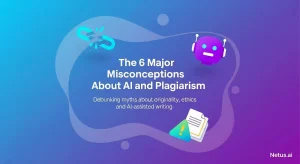Acceptable Plagiarism Percentage in the UK

Ashley Merit
Content writer and editor for Netus.AI
Acceptable Plagiarism Percentage in the UK. Plagiarism has been a long-standing issue in the world of academia, with instances of copied content in academic papers. Although cheating among students has always been present, the rise of the internet has made copying content much easier. It is essential for students and scholars to be aware of the acceptable plagiarism percentages in the UK, especially in their respective institutions.
Despite the availability of vast amounts of information found online, not all writers resort to copying content. Sometimes, unintentional plagiarism might seep into their work. It makes understanding the acceptable percentage of plagiarism in the UK and developing good practices for producing original content particularly important.
Key Takeaways
- Plagiarism is a pervasive issue in academic institutions, and the internet has made cheating more accessible.
- While some writers may unknowingly include copied content, it is crucial to be aware of acceptable plagiarism percentages.
- Understanding what constitutes plagiarism and developing good practices are essential to maintain academic integrity.
How are Online Plagiarism Checkers Beneficial for People?
Online plagiarism checkers generate similarity reports which reveal the presence of copied content in a document. These reports provide a plagiarism percentage, which represents the total amount of duplicated content in the document. A higher percentage typically signals the presence of unoriginal material.
Plagiarism levels of about 10 to 15% are commonly deemed acceptable, but even a 10% score may not guarantee a document’s originality. For instance, this percentage could represent a whole paragraph copied without proper citation. As such, solely relying on plagiarism percentages isn’t foolproof in determining a document’s authenticity.
Nonetheless, online plagiarism checkers are beneficial for the following reasons:
- They promote the understanding of proper citation practices.
- They provide valuable feedback to improve the writing process.
- They guide users in avoiding failure due to unintentional plagiarism.
It’s important to note that sometimes, high plagiarism percentages might result from cited passages being mistaken for plagiarized content. Hence, it’s crucial to carefully assess the generated similarity report and recognize the reasons behind the indicated level of plagiarism.
To Curb Plagiarism, Write a Plagiarism-Free Document
To effectively minimize plagiarism in academic writing, students should concentrate on crafting unique content, diligently citing appropriate references, and making sure those sources are relevant to their assignments.
In the modern age, countless online resources cover a wide array of topics. However, it is crucial to choose the most suitable references for one’s paper instead of relying solely on external information. Incorporating individual perspectives, insights, and conclusions contributes to a well-rounded essay, reducing the risk of accidental or patchwork plagiarism.
For educators, emphasizing the importance of original thought and providing a clear understanding of self-plagiarism, assessments, and academic integrity within their field of study, would help students grasp the significance of honest work in their education. In turn, this may discourage practices such as commissioning papers or paying for model essays.
Process of Avoiding Plagiarism
To effectively avoid plagiarism, adhere to these steps:
- Create a unique write-up: Focus on writing the paper without integrating any sources at first. This allows for individual ideas and conclusions to form.
- Organize and document sources: Record each source immediately to prevent forgetfulness and ensure proper citation.
- Incorporate notes: Clarify the relevance of reference passages used within the paper by explaining their significance in the notes section.
- Consistent citation format: Always use a single, institution-prescribed citation style for listing cited works.
Additionally, it is crucial to check the paper for plagiarism using a high-quality plagiarism checker. Utilize the results from the plagiarism scanner to rectify any unintentional mistakes within the paper. By following these guidelines and paying attention to the referencing process, writers can prevent plagiarism while creating well-researched, original work with proper acknowledgement of sources such as direct quotations, images, and in-text citations.
Online Services for Checking Plagiarism in Academic Papers
Manually identifying plagiarism in text files can be challenging, especially when recalling all the sources utilized while writing the paper. Unintentionally incorporating ideas from previous lessons also poses a risk for unplagiarized content.
Ensuring proper citation for influenced passages or paraphrased content is crucial; however, incomplete citations or mistakes in the works cited page might cause plagiarism issues. Errors in attributions or spelling can further aggravate these problems.
Manually checking a paper for every small error leading to plagiarism is often unfeasible. Thankfully, online tools can effectively detect plagiarism and correct grammatical or spelling mistakes. Some popular tools include:
- Grammar checkers: These tools assess the grammatical correctness of the paper.
- Plagiarism checkers: By scanning the uploaded document for copied content, these tools compare the text with multiple internet sources to identify plagiarism.
One well-known plagiarism checker is Turnitin, which is widely used in academic settings.
Upon completion of the scanning process, the duplicated sections are highlighted, and sources of the copied text are displayed. A comprehensive plagiarism report is generated, providing valuable insights into the paper’s quality.
By using these online services, writers can significantly improve the originality and quality of their academic papers, ensuring they comply with integrity standards in their respective fields.
Use Plagiarism Detector Tool
In today’s digitally connected world, finding a reliable plagiarism detection tool can be challenging. Many checkers employ basic scanning methods that may not catch intellectual theft that has been purposefully modified to evade detection. However, utilizing an AI-powered online plagiarism scanner can help identify even the most cunningly altered content^[1^].
These advanced tools are capable of identifying various types of plagiarism and are particularly beneficial in the academic sphere. By understanding the significance of plagiarism, users can work towards eliminating duplicate content in scholarly papers. Tools like plagiarism detectors simplify the process and yield similarity reports after scanning, making it easier to remove copied content.
Some effective formatting techniques for your articles include:
- Tables: Organize data in an easy-to-read format
- Bullet points: Compile lists and key points concisely
- Bold text: Emphasize important information
Adopting these strategies can help deliver information in a clear and concise manner while avoiding exaggeration or falsehoods. By using an appropriate plagiarism detection tool, users can confidently ensure the originality of their work and maintain academic integrity.
Frequently Asked Questions
Maximum Threshold for Plagiarism in University Assignments
Different universities and academic institutions may have varying policies regarding acceptable plagiarism levels in assignments. Generally, it is best to strive for a plagiarism percentage of 0% to ensure originality and proper citation of sources in your work.
Determining Acceptable Plagiarism Percentages in Theses
The acceptable percentage of plagiarism in a thesis varies depending on the institution, department, or the specific guidelines provided by your university. Some universities may accept a plagiarism threshold of around 10%, but it is recommended to check with your institution for specific guidelines.
Acceptable Similarity Levels in Research Papers
In research papers, the acceptable similarity percentage may depend on the publisher. For instance, Springer specifies that up to 15% similarity is permitted. It is crucial to familiarize yourself with the guidelines of the publisher or the academic institution you are submitting your research to, as different organizations may have different policies in place.
Identifying Plagiarism through Turnitin Similarity Percentage
Turnitin’s similarity percentage indicates the level of similarity in content between your submitted work and other sources. However, a high similarity percentage does not automatically indicate plagiarism. It is crucial to investigate each similar passage to determine whether it constitutes plagiarism or is a correctly cited reference.
Allowable Plagiarism Limit in a Master’s Thesis
The allowable limit of plagiarism in a master’s thesis may vary among academic institutions and departments. Nevertheless, less than 10% is generally considered an acceptable limit. Always consult your university’s specific guidelines to ensure compliance with their requirements.
Acceptable Plagiarism Levels in the University of London’s Academic Submissions
The University of London follows strict plagiarism guidelines, defining plagiarism as presenting someone else’s thoughts, words, or other output in a way that may be assumed as your own. Plagiarism in any form is considered an assessment offence, and students must adhere to the university’s policies and guidelines to avoid academic penalties.

The Role of AI in Content Ideation and Topic Generation | NetusAI
AI’s contribution to content ideation and topic generation AI plays a crucial role in content creation and topic generation. Its effective application significantly reduces preparation

Leveraging AI to conquer writer's block | NetusAI
Overcoming writer’s block with AI Writer’s block affects all writers, new or experienced. Even for the most accomplished writers, this common and frustrating problem presents

AI Overviews: A Comprehensive Guide | NetusAI
A Comprehensive Guide to AI Overviews Google has integrated AI Overviews into its search results as a knowledge panel. This feature acts like an AI

6 Common Misconceptions Regarding AI and Plagiarism | NetusAI
The 6 major misconceptions about AI and plagiarism Regarding AI and plagiarism, numerous myths, misconceptions and assumptions are circulating. Let’s distinguish between fact and fiction.

My writing is repeatedly flagged as AI generated by detection software | NetusAI
AI detectors consistently identify my writing as AI generated Even original, human-written content can face challenges from AI content detection false positives, impacting copywriters and

People Also Ask: Understanding their importance and function in search results
People Also Ask: Understanding their importance and function in search results A People Also Ask (PAA) search result is a zero-click Google response. It presents
